Anubias nana – is a popular aquatic plant known for its compact size and resilient nature. It features broad, dark green leaves that add a touch of elegance to any aquarium or aquascape. This versatile plant can thrive in a variety of water conditions, making it suitable for both beginners and experienced aquarists. Anubias nana is a favored choice for aquascaping enthusiasts looking to create visually appealing and harmonious aquatic environments.
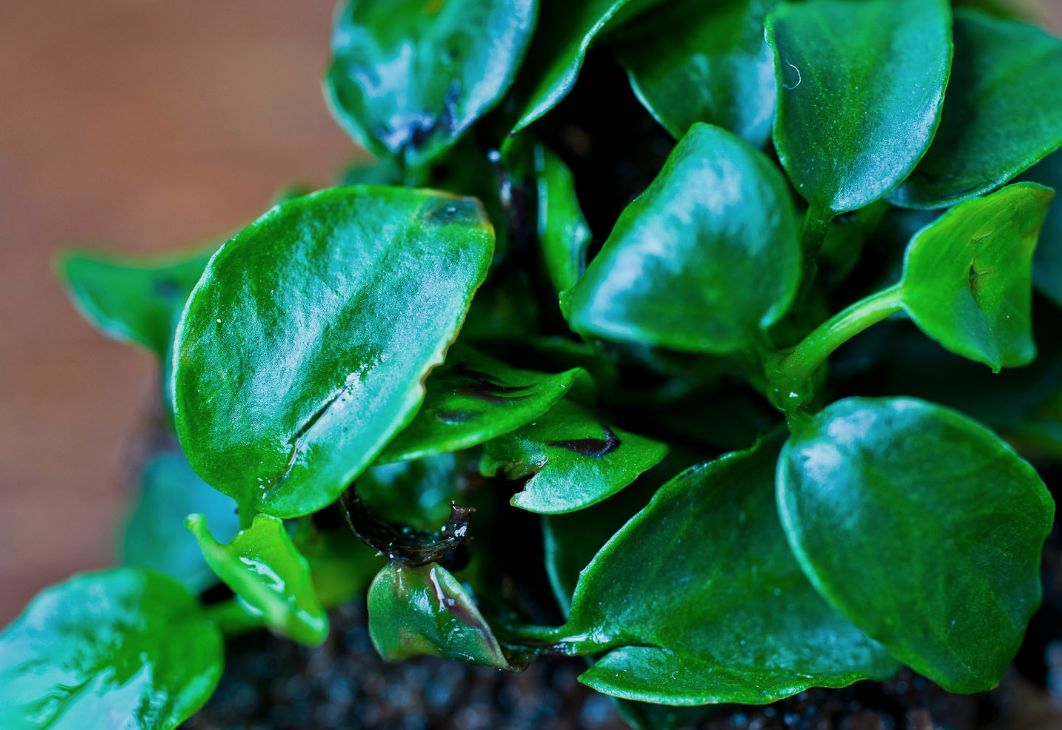
Contents
Plant natural habitat
Anubias barteri var. nana is encountered in the tropics of West Africa (Limbe, Cameroon), in forest bogs, shores of small rivers and streams, in or out of water with its roots in it and leaves growing above. During floods the plant gets completely covered with water.
The water parameters in its natural habitat include a temperature range of 72-82°F (22-28°C), a pH range of 6.0-7.5, and a water hardness (GH) of 10-15 dGH. Additionally, the water flow is usually moderate to low, and the lighting conditions are typically moderate, with partial shade provided by overhead vegetation.
Description
| Scientific Name | Anubias barteri var. nana |
| Genus | Anubias |
| Family | Araceae |
| Common names | Anubias Nana |
| Plant Type | Rhizomatous |
| Lighting Needs | Low to Moderate |
| Growth rate | Slow |
| CO2 | Not required, but beneficial |
| Temperature Required | 22-28 °C (72-82 °F) |
| pH Level | 6.0-7.5 |
| KH | 3-10 |
| Care Level | Easy |
| Minimum tank size | 10 gallons |
| Maximum plant size | Up to 4 inches (10 cm) |
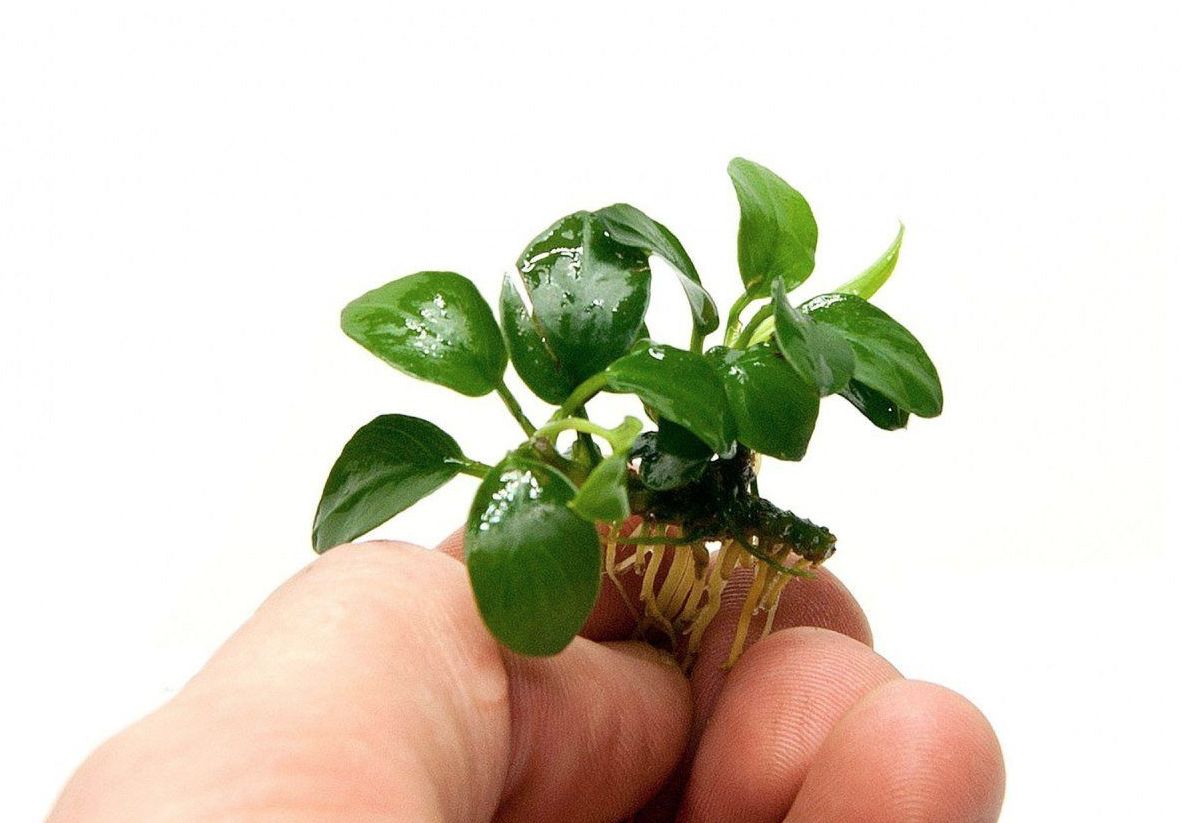
Description
Nowadays there are many varieties of anubias which are popular among aquarists. All these plants come from tropical Africa areas. Most of the species can be rather seldom encountered in amateurs tanks, since they are challenging in terms of keeping and care as well as because they grow slowly, especially in tanks.
Anubias barteri var. nana is one of the most slow-growing tank plants and one of the most widespread among all species. It has become popular due to its small size. Most of species are quite large. For example, Anubias barteri var. barteri grows up to 20 inches (50 cm high). Anubias nana size as a rule doesn’t exceed 10 cm, more often it is about 3-4 cm high.
The plant has trailing roots and tigellum with a rosette of petiolate leaves. Its lamina is solid with feather like venation, the midrib is on the down side of the leaf.
This species forms thick imbricated carpet of oval dark green glossy leaves. The largest bushes are about 4 inches (10 cm) high. You should place plant in the foreground of a tank. During the whole year the plant grows equally both in aquatic and air medium.
Anubias nana blooms from time to time. If it happens quite deep in the water, the flowers usually don’t reach the water surface.
The flower itself is quite plain and for those who have no idea how it is supposed to look the blooming may go unnoticed. The flower can live for several weeks. When it becomes unattractive it’s better to cut it off without waiting for natural end of its life cycle.

The flowers of Anubias nana are relatively rare in aquarium conditions, as they typically require specific conditions to bloom.
The flowers emerge from a thick stalk that grows from the rhizome of the plant. The blooms are typically small, white or cream-colored, and have a spadix-like structure surrounded by a spathe. The spathe can vary in shape and size, ranging from cylindrical to heart-shaped, depending on the specific variety.
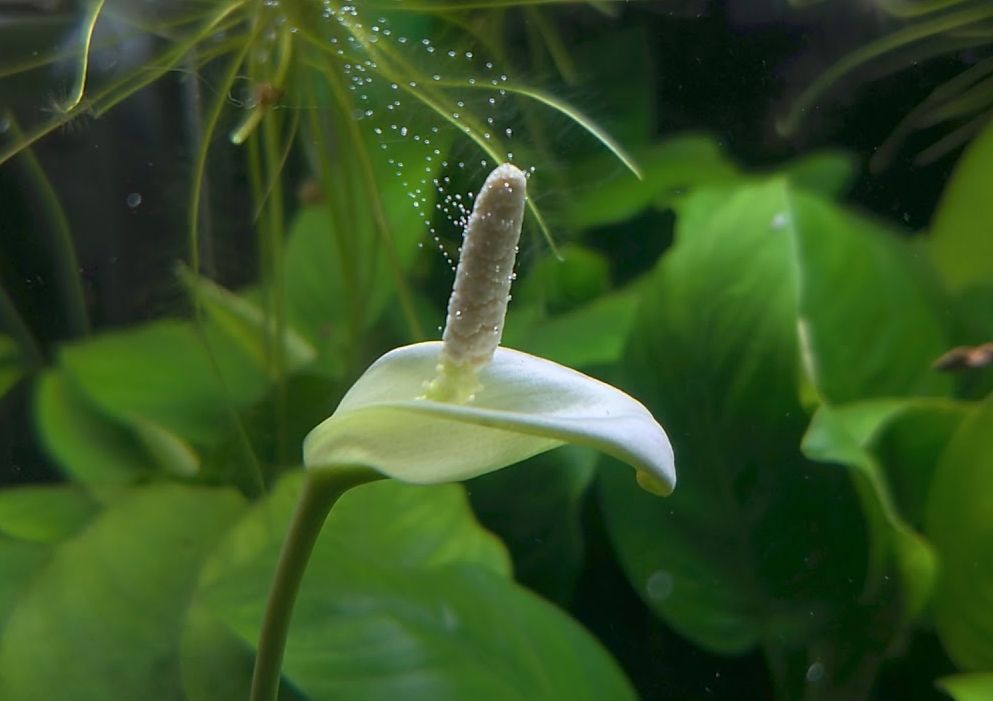
Anubias barteri var. nana vs Anubias nana petite
Except Anubias nana there is one more small sized species – Anubias barteri var. nana petite. It is even smaller. The size of its leave doesn’t exceed 1 inch (2.5 cm).
They are actually the same plant, with “Anubias nana” being the older and more commonly used scientific name, while “Anubias nana petite” is a more recent commercial name given to a smaller variant. They both refer to the same compact and resilient aquatic plant with broad dark green leaves, suitable for adding elegance to aquariums or aquascapes with minimal maintenance required.
Nowadays nana petite is a quite rare variety and it will be for a long time, since it grows even slower.
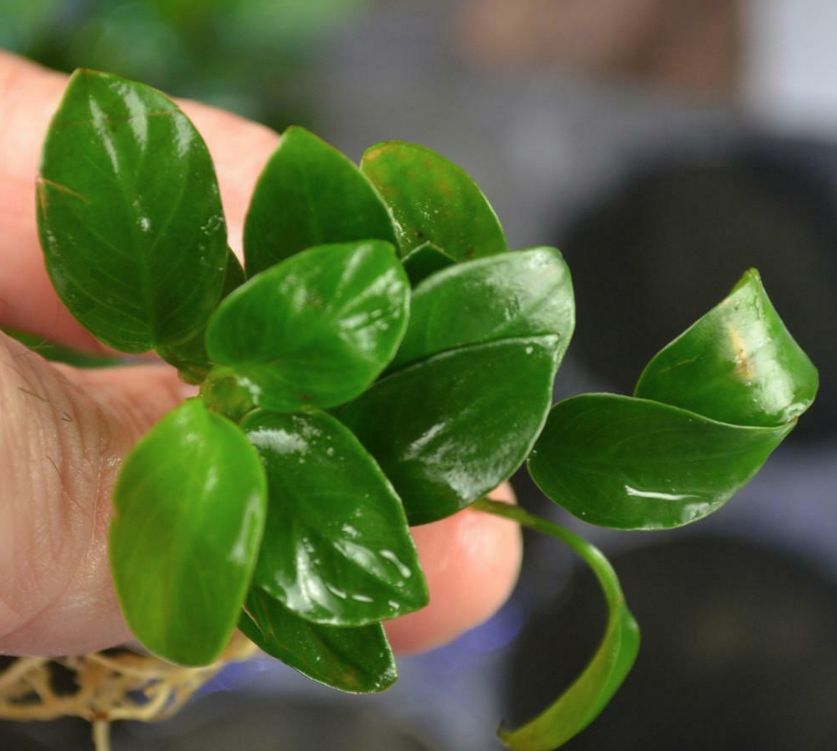

Difficulties in keeping
Anubias are quite undemanding tank plants. Additional CO2 and fertilizers supply isn’t necessary for them. However, you shouldn’t forget about optimal pH level for tank plants, it should be in the range from 6 to 7.
Weekly water renew (30% of the tank volume) can supply anubias with all required nutrients. The plant has low growth rate which means that it doesn’t need large amounts of nutrients.
Care and keeping in a tank
Light requirements
Anubias barteri var. nana thrives best under moderate lighting conditions. Although it is adaptable and can grow in low light environments, providing moderate light will enhance its health and encourage lush, vibrant foliage.
In tanks with bright lighting, it is advisable to place Anubias nana in the shade of smaller-leaved plants to prevent excessive light exposure. Both natural and artificial light sources can be used effectively. However, ensure the plant is shielded from direct sunlight, as this can harm its growth.
The lighting intensity in your aquarium should be adjusted based on the needs of other tank plants. Anubias nana is particularly resilient to shade, making it an excellent choice for tanks with varying light conditions. Aim to provide at least 8 hours of light each day to support optimal growth and development of the plant.
Water parameters
Water hardness and pH have no sufficient effect on growth rate. It is approximately the same both in hard water with weakly alkaline reaction and in highly soft water with acidic reaction (hardness 2-16°, pH 6-8). It is important to note that Anubias is not overly sensitive to water parameters and can tolerate slight variations, making it suitable for a variety of freshwater aquarium setups. Regular water changes and maintaining stable conditions are generally recommended for the overall health and growth of the plant.
The tank water must be clean. Mud particles that appear in the water settle on the plant leaves and affect the nutrition process.
Water temperature
The plant can be kept only in tropical tanks. Preferable tank water temperature is about 24-28 °C. If the temperature decreases up to 20 °C, it will cause the plant stasis. It is important to maintain a stable temperature within this range to ensure the well-being of the plant. Sudden or drastic temperature fluctuations can stress or damage the plant.
Substrate
Anubias nana is a versatile plant that can tolerate a variety of substrates. It is an epiphytic plant, meaning it naturally grows attached to rocks, driftwood, or other surfaces rather than being rooted in the substrate. As a result, the type of substrate used is not critical for its growth.
When planting only its roots should be buried into the substrate, not the rhizome. The rhizome should not be buried in the substrate but rather attached to hardscape or left partially exposed. Growing anubias nana rhizome above the substrate and forms a tight matting of the roots which supports the whole plant above the substrate. Quite a lot of tank fishes find their shelter in this matting of the roots later. If rotting has already occurred, trim away the affected portions of the rhizome using tools, and provide suitable conditions for the remaining healthy portions to recover.
A common approach is to use a fine-grained substrate such as sand, gravel, or a specialized aquarium planting substrate. These substrates provide stability for the plant’s roots while allowing water circulation and nutrient flow. Additionally, adding a layer of nutrient-rich substrate or using root tabs can provide supplementary nutrients to promote healthy growth.
Propagation
Anubias nana rootstock is quite branchy. New shoots that you see on it can be cut off and planted somewhere else in a tank once they form about 5-6 leaves. This is how this plant is cultivated in aquarium. Getting seeds is almost impossible for amateurs.
Does anubias nana need to be planted?.
Anubias nana is an epiphytic plant, which means it naturally grows attached to rocks, driftwood, or other surfaces rather than being rooted in the substrate. It absorbs nutrients through its roots, but it does not heavily rely on the substrate for its growth.
For optimal growth and to avoid potential issues like rhizome rot, it is recommended to attach Anubias to hardscape elements in your aquarium. You can use fishing line, cotton thread, or plant-safe glue to secure it to rocks or driftwood. The roots can then anchor onto the hardscape, while the rhizome remains exposed or partially buried.
By attaching Anubias to hardscape instead of planting it in the substrate, you can ensure better nutrient flow, prevent rotting, and easily reposition the plant if needed.
Can anubias nana grow on rocks?
Yes, it can grow on rocks, making it a popular choice for attaching to hardscape elements in aquariums. In its natural habitat, Anubias species, often grow attached to rocks, driftwood, or other surfaces along the banks of rivers and streams.
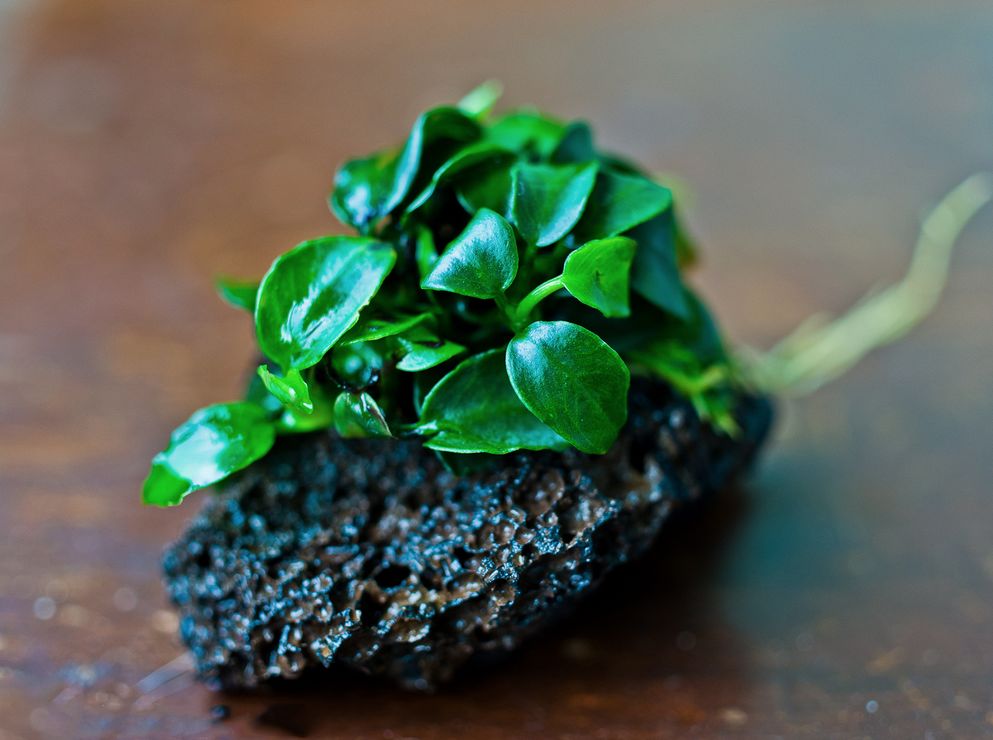
How to attach Anubias to rocks or wood?
When attaching plant to hardscape elements like driftwood or rocks, using glue can be an effective method to secure the plant in place. Here’s how you can use glue to attach:
- Select a suitable aquarium-safe glue: Cyanoacrylate, commonly known as super glue, can be used in aquariums for this purposes. Cyanoacrylate is commonly used to attach aquarium plants to hardscape elements like driftwood or rocks.
- Prepare the plant and hardscape: Gently rinse the plant under running water to remove any debris or excess gel from the roots. Clean the surface of the driftwood or rock where you plan to attach the plant, ensuring it is free from any dirt, algae, or other contaminants.
- Apply a small amount of glue: Use a small amount of aquarium-safe glue, following the instructions provided by the manufacturer. Apply the glue sparingly to the area where the plant’s roots will make contact with the hardscape. Curing times can vary, but it usually takes a few minutes.
- Attach the plant: Carefully place the Anubias onto the glued area, pressing it gently against the hardscape. Ensure that the roots are in contact with the glue and the rhizome is properly positioned. Hold the plant in place for a few moments to allow the glue to set and create a bond.
Remember to choose a glue that is specifically formulated for aquarium use or Cyanoacrylate, as using regular household glue or adhesives can be toxic to aquatic life.
How long does Anubias nana take to grow?
It is a slow-growing plant, and the rate of growth can vary depending on various factors such as lighting, water parameters, and nutrient availability. On average, it can take several months for Anubias nana to show significant growth and develop new leaves.
Under optimal conditions, with moderate lighting, stable water parameters, and adequate nutrient levels, you can expect to see noticeable growth and the emergence of new leaves every few weeks or months. However, it’s important to keep in mind that it is not a fast-growing plant, and its growth rate is generally slower compared to many other aquarium plants.
Patience is key when growing Anubias nana, as it may take time for the plant to establish itself and develop. It is crucial to provide a stable and healthy environment, proper lighting, and suitable nutrient levels to support its growth. Regularly monitor the plant’s progress and make any necessary adjustments to optimize its growth conditions.
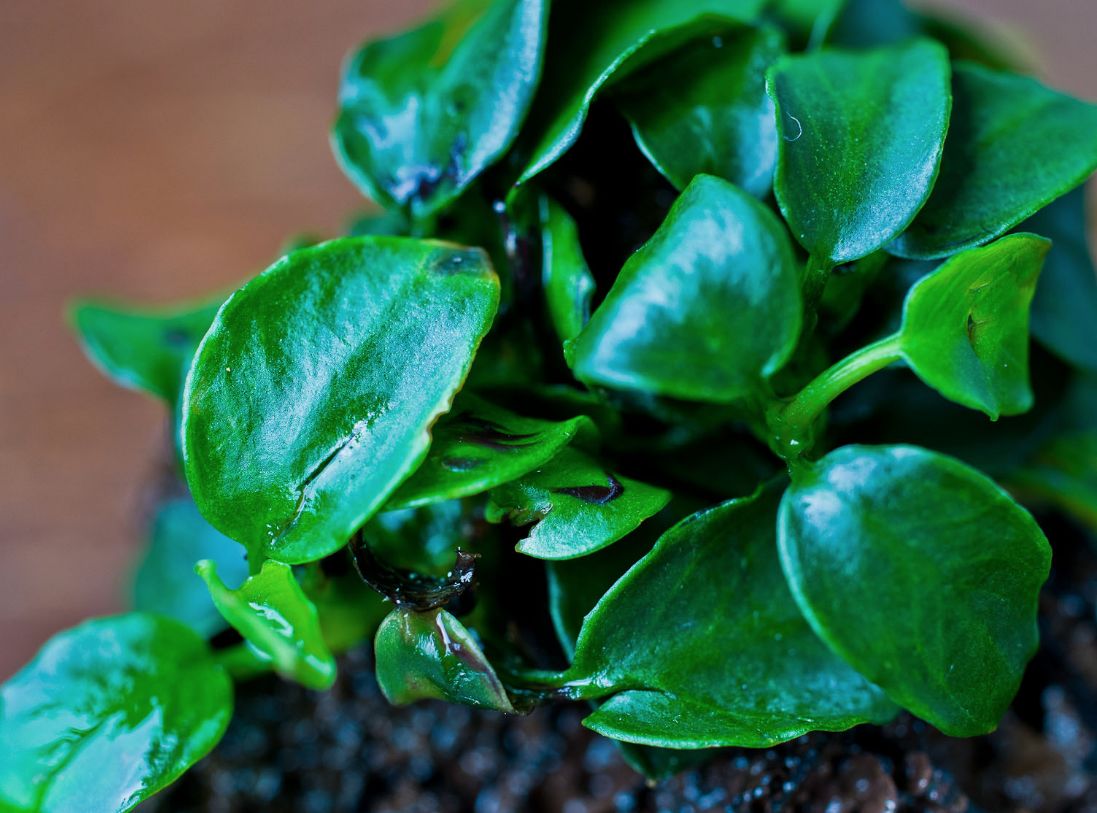
Do Anubias need to be fully submerged?
Anubias plants are typically found in nature growing along the banks of rivers and streams, where their roots are submerged while the rhizome and leaves are partially or fully exposed to air. This means that plant can tolerate both fully submerged and partially emerged conditions.
In aquariums, Anubias can be grown fully submerged, which is the most common method of cultivation. When fully submerged, the plant can still thrive and grow as long as its basic care requirements are met, such as appropriate lighting, water parameters, and nutrient availability.
However, plant can also be grown in partially emerged conditions, where the rhizome and some portions of the leaves are allowed to extend above the waterline. This can create an interesting aesthetic effect in the aquarium and mimic their natural habitat. Just make sure to keep the rhizome moist and avoid letting it dry out.
Keeping in a paludarium
This plant can be grown in a paludarium and in a greenhouse with high humidity level. As a terrestrial plant it prefers temperature 26-30 °C and ground that consists of humus, peat and sand. We should mention that unlike other anubias kinds this one demonstrates the same growth rate both in a tank and in a greenhouse. However, in the latter it doesn’t get covered with algae and looks more appealing.
Anubias nana growing in a tank almost doesn’t require any mineral feeding. If it grows in a greenhouse, you can feed it twice a month with complex fertilizers dissolved in irrigation water according to the recommendation on how to use these fertilizers properly.